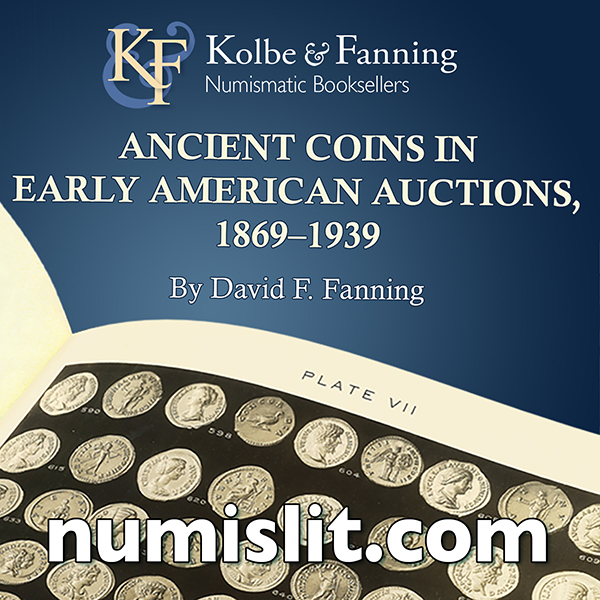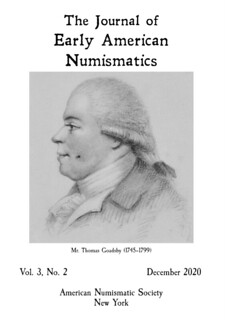
PREV ARTICLE
NEXT ARTICLE
FULL ISSUE
PREV FULL ISSUE
JOURNAL OF EARLY AMERICAN NUMISMATICS DEC 2020The latest issue of JEAN, the Journal of Early American Numismatics has been published by the American Numismatic Society. Here is the table of contents and an excerpt from the Editor's Preface by Christopher R. McDowell. -Editor
Thomas Goadsby's Letterbook
S. C. Kingman and the Fugio Restrikes
Evaluation of Lead/Pewter Cast Counterfeit Coins Found in Philadelphia During the Construction of Route I-95
Evaluation of William III Cast Copper Counterfeit Halfpence Found During
Construction of Route I-95 through Philadelphia
Coin Finds from the Nickerson Site, Chatham, MA
This issue marks the conclusion of JEAN's third year. Since our last issue, we have received several accolades. The Numismatic Literary Guild (NLG), recently named Q. David Bowers' article "John J. Ford, Jr.: A Life in Three Portraits," which appeared in Vol. 2, No. 1 of JEAN the best article in the area of numismatic history or personalities. In my Editor's Preface to that issue, I stated that it was the best and most heartfelt article Dave had ever written. In preparation for writing this preface, I reread Dave's article—it is still brilliant. If you did not read it, please do yourself a favor and go back and do so now. In addition, the NLG handed out two more awards to JEAN; one for best article on Early American Coins and the second was the James L. Miller Memorial Award for best Article or Story of the Year, both going to my co-author Julia Casey and me for our study on the Fugio restrike dies in Vol. 2, No. 2 of JEAN. The editors and staff of JEAN are pleased to provide our subscribers with top-notch, award-winning articles, and we shall continue to do so. This issue has a short article building on our study of Fugio restrike dies. Julia has prepared a monograph of S.C. Kingman's potential role in the restrikes. Kingman, a colorful character whom we were unaware of when we drafted our article last year, is a new entrant to the saga. As you shall see, Kingman was Chester Scott's co-worker at the Wheeler & Wilson Mfg. Co. in Bridgeport, Connecticut. Our previous article conclusively tied the Mattatuck Museum's Fugio restrike die to Chester Scott. Julia's current article links a Newman 106 overstrike to Kingman that was struck from the Mattatuck die. We slowly pull back the onion's layers to reveal more clues to the enigmatic Fugio restrike story—a mystery that was once thought impossible to solve is well within our grasp. What else is in this issue? The short answer is Thomas Goadsby—he is on the cover, and his private business correspondence encompasses half of this issue's pages. Let us start with the front cover. On the cover is the only known portrait of Thomas Goadsby. The drawing is in my collection, and I am glad to share it with our subscribers to help put a face to the name. The portrait tells us information in addition to what is learned from Goadsby's business correspondence. My purchase of the picture was based on low-quality images, and I was fearful at the time that there was a hole in the paper. When it arrived, I was relieved to see there were no holes. What I mistook for a possible hole was something else entirely. If you look at the portrait, you will see a dark spot on Goadsby's left cheek. It is known as La Mouche in French—what we call a beauty mark in America. These were small black leather patches applied to the face by members of the upper-class. The area of the face to which La Mouche was applied carried symbolic meaning. Around the mouth or lips of a woman, La Mouche had a much different meaning from the same beauty marks placed near the eyes. La Mouche, placed on the cheek, was called La Galante. Thus, the portrait tells us that Goadsby viewed himself as gallant, or at least that is how he wished others to perceive him. The wig and dress are those of a sophisticated English gentleman—as they say, a picture is worth a thousand words. Goadsby is a historical gadfly, popping in and out of our numismatic story but never landing long enough to be well-defined. The documents presented here only cover 1787 and 1788. Still, fortunately, this is part of the time when he was engaged in New Jersey copper coin production. Those of you who wish to read only the entries relating directly to Goadsby's coinage efforts may turn to Appendix I, starting on page 95. There you will find a summary of, and citation to, the entries discussing coining. Instead of only publishing these numismatics entries, we are publishing transcripts of all of Goadsby's business letters. We made this editorial decision for several reasons: First, we don't know what we don't know. In other words, it is hard to tell if the other letters contain some important hidden link to numismatics of which we are currently unaware. To leave such a letter out would be an extreme disservice to future researchers. Second, the corpus of the letters place the numismatic materials into proper context and help provide a more complete picture of who Goadsby was. Finally, we just found Goadsby to be a pretty darn interesting fellow. This transcript's preparation was extremely time-consuming, taking the combined efforts of Jack Howes, Gary Trudgen, and Julia Casey nearly a year to complete. If you want to know what it is like to transcribe materials like these, you may turn to page 6 and look at Figure 1. See how long it takes you to read the original letter, and if you can read every word. Having followed the progress of the transcription effort, I can attest that Figure 1 is one of the easier pages to decipher. The trio of transcribers has done an extraordinary job with these materials. We are very proud of the final product, which will provide valuable primary source material to researchers from this day forward. The next two articles are by a team led by Roger Moore and involve counterfeit coins discovered during the construction of I-95 through the heart of what was once the wharf district of Philadelphia. I have previously stated here that the topic of counterfeit halfpence is not my favorite, but even I was drawn into this story. I must confess that reading these two articles more than tripled my knowledge of the subject and piqued my interest into this esoteric corner of numismatics. The articles are yet another example of the marriage between numismatics and metal detecting, a union we should encourage. In the years to come, many of the great discoveries in numismatics will come from metal detectorist—I am not just talking about finding rare coins, but the window into the past that is opened by studying the assemblage of material recovered. Before I leave this topic, I want to make a prediction. The second article, "Evaluation of William III Cast Copper Counterfeit Halfpence Found During Construction of Route I-95 Through Philadelphia," will receive an award of some type. It is fantastic! The scientific approach and analysis of the coins is a model of how numismatic research should be conducted. It is not just amateur metal detectorists who make great finds. Professional archeologists still uncover colonial coins from time to time too; and when they do, it is always welcome news. Our final article comes from Alan M. Stahl, the Curator of Numismatics at Princeton, University. Alan explores four coins found during the excavation of an old foundation on Cape Cod. Finds like these are incredibly significant to our understanding of which coins were in circulation in Colonial America. Alan's article is short but important. I am grateful to make Alan's acquaintance. I admire the work he performed during his twenty years at the ANS, particularly on American medals.
For more information on the American Numismatic Society, see:
For more information on the Journal of Early American Numismatics, see:

Wayne Homren, Editor The Numismatic Bibliomania Society is a non-profit organization promoting numismatic literature. See our web site at coinbooks.org. To submit items for publication in The E-Sylum, write to the Editor at this address: whomren@gmail.com To subscribe go to: https://my.binhost.com/lists/listinfo/esylum All Rights Reserved. NBS Home Page Contact the NBS webmaster 
|
